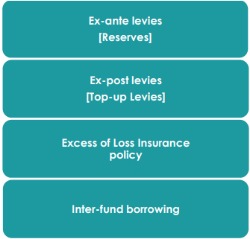Background
ICCL has developed a ‘Cascade model’ as the framework for funding the Scheme and ensuring sufficient liquidity in the event that a failure of an authorised investment firm gives rise to compensation under the Act. The Cascade model represents a prioritised approach to be taken by the ICCL, depending on the seriousness of the failure, to access funds for the purpose of making compensation payments.
This approach is supported by the finding in the EU Commission’s study that the availability of multiple sources of funding, even if never activated, enhances the viability of a scheme.
The ICCL model consists of the following capital and synthetic funding elements (not necessarily in the order presented below

The implementation sequence of the individual elements of the cascade model is determined by the Board depending on circumstances prevailing at the time of the failure.
The ICCL Cascade model has been significantly strengthened with the addition of an “Excess of Loss” Insurance policy. However, the Board is aware of the difficulties that may be encountered in renewing this policy on an annual basis.
The ICCL’s Excess of Loss Insurance policy is a “specie” insurance policy with annual renewal subject to detailed preparations by the Company and lengthy negotiations and discussions with our brokers and Lloyds Underwriters. Significant difficulties were experienced in the 2012/2013 renewal cycle due to perceived increased underwriting risks following the failure of investment firms, not only in Ireland, but internationally e.g. MF Global and Phoenix.
Recent Use of the Cascade Model
In respect of the failure of CHC in 2011, the Board deployed the Cascade model in the following manner:
• €15 million will be paid directly from the reserved funds of Fund A;
• The potential additional €4.7 million will be met from the Excess of Loss Insurance policy;
The decision of the Board not to require additional top-up payments was based on the following criteria:
• Sufficient reserves were available to meet the Excess of Loss Insurance policy excess of €15 million;
• No new failures had arisen that would have given rise to significant claims for compensation;